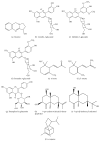Medicinally Important Herbal Flowers in Sri Lanka
- PMID: 31263504
- PMCID: PMC6556806
- DOI: 10.1155/2019/2321961
Medicinally Important Herbal Flowers in Sri Lanka
Abstract
Background: The plant kingdom is rich with a numerous number of plants with various medical properties which can be used to treat various medical issues. Sri Lanka is a country full of biodiversity which is gifted with many plant resources. It has a rich history of traditional medicine systems consisting of Ayurveda, Unani, and Deshiya Chikitsa, where these plant resources are used as remedies for the diseases. In the traditional medicine system, various plant parts such as leaves, roots, fruits, flowers, and bark are used to treat disease conditions. Although less attention is paid to the medicinal importance of the flowers, some of them have been used to treat many diseases from the ancient time. Some properties of the flowers may differ from the properties of the other plant parts. For example, Sesbania grandiflora (Katuru murunga) flowers have shown anticancer properties against various cell models whereas some flowers have shown antispermatogenic properties. Flowers of Woodfordia floribunda (Militta) are added as fermenting agents in the preparation of Arishtas in Ayurveda. Also the most popular Clove oil is obtained from the flower buds of Syzygium aromaticum (Karabu-neti) which is used to treat toothaches since it has antibiotic and antiseptic properties. This article gives an overview of herbal flowers used in the traditional medicine system of Sri Lanka and their pharmacological importance.
Method: A comprehensive literature survey was done on the medicinally important flowers in Sri Lanka. Data was collected from Libraries of Ayurveda in Sri Lanka and from scientific databases.
Results: According to the survey many flowers are used as astringent, cardiac tonic, and febrifuge. Also some flowers are used to treat dysentery, diarrhoea, and indigestion. Some flowers are useful in the treatment of bleeding piles while some are useful in the treatment of asthma and bronchitis.
Conclusion: It was revealed that there are many flowers with valuable therapeutic effects. Traditional medicine systems prevailing in Sri Lanka have made use of these flowers with therapeutic effects to cure so many diseases. The review of medicinally important herbal flowers provides knowledge and pharmacological leads which will help for the wellbeing of the human beings. Although there are phytochemical studies done to identify the chemical compounds on some flowers, chemical composition of many flowers remains unrevealed. So further studies need to be done to identify the chemical composition of these flowers.
Figures
Similar articles
-
The traditional system on medicine in Sri Lanka.J Ethnopharmacol. 1980 Mar;2(1):71-3. doi: 10.1016/0378-8741(80)90033-1. J Ethnopharmacol. 1980. PMID: 7464187
-
Screening for bioactive secondary metabolites in Sri Lankan medicinal plants by microfractionation and targeted isolation of antimicrobial flavonoids from Derris scandens.J Ethnopharmacol. 2020 Jan 10;246:112158. doi: 10.1016/j.jep.2019.112158. Epub 2019 Aug 14. J Ethnopharmacol. 2020. PMID: 31421182
-
Ethnopharmacological survey on medicinal plants used in snakebite treatments in Western and Sabaragamuwa provinces in Sri Lanka.J Ethnopharmacol. 2016 Feb 17;179:110-27. doi: 10.1016/j.jep.2015.12.041. Epub 2015 Dec 25. J Ethnopharmacol. 2016. PMID: 26724891
-
Scientific basis for the use of Indian ayurvedic medicinal plants in the treatment of neurodegenerative disorders: ashwagandha.Cent Nerv Syst Agents Med Chem. 2010 Sep 1;10(3):238-46. doi: 10.2174/1871524911006030238. Cent Nerv Syst Agents Med Chem. 2010. PMID: 20528765 Review.
-
Plants used to treat diabetes in Sri Lankan Siddha Medicine - An ethnopharmacological review of historical and modern sources.J Ethnopharmacol. 2017 Feb 23;198:531-599. doi: 10.1016/j.jep.2016.07.053. Epub 2016 Jul 19. J Ethnopharmacol. 2017. PMID: 27448453 Review.
Cited by
-
Beneficial medicinal effects and material applications of rose.Heliyon. 2023 Dec 10;10(1):e23530. doi: 10.1016/j.heliyon.2023.e23530. eCollection 2024 Jan 15. Heliyon. 2023. PMID: 38169957 Free PMC article. Review.
-
Computational identification of PDL1 inhibitors and their cytotoxic effects with silver and gold nanoparticles.Sci Rep. 2024 Nov 4;14(1):26610. doi: 10.1038/s41598-024-77868-8. Sci Rep. 2024. PMID: 39496756 Free PMC article.
-
Antidiabetic Activity of Widely Used Medicinal Plants in the Sri Lankan Traditional Healthcare System: New Insight to Medicinal Flora in Sri Lanka.Evid Based Complement Alternat Med. 2021 Feb 9;2021:6644004. doi: 10.1155/2021/6644004. eCollection 2021. Evid Based Complement Alternat Med. 2021. PMID: 33628307 Free PMC article. Review.
References
-
- Selvamohan T., Ramadas V., Kishore S. S. S. Antimicrobial activity of selected medicinal plants against some selected human pathogenic bacteria. Advances in Applied Science Research. 2012;3(5):3374–3381.
-
- Chandrasena J. P. C. The chemistry and Pharmacology of Ceylon and Indian Medicinal Plants. 1st. Colombo, Sri Lanka: Harrisons & Crosfield, ltd; 1935.
-
- Said H. M., Saeed A., De Silva L. A. Medicinal herbal A Research Publication of Bait Al-Hikmah at Madinat Al-Hikmah. 1st. Karachi, Pakistan: 1996.
Publication types
LinkOut - more resources
Full Text Sources


